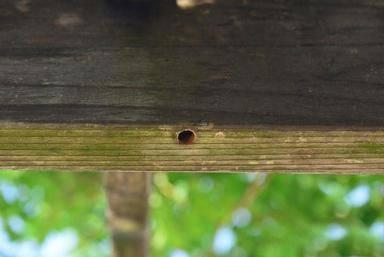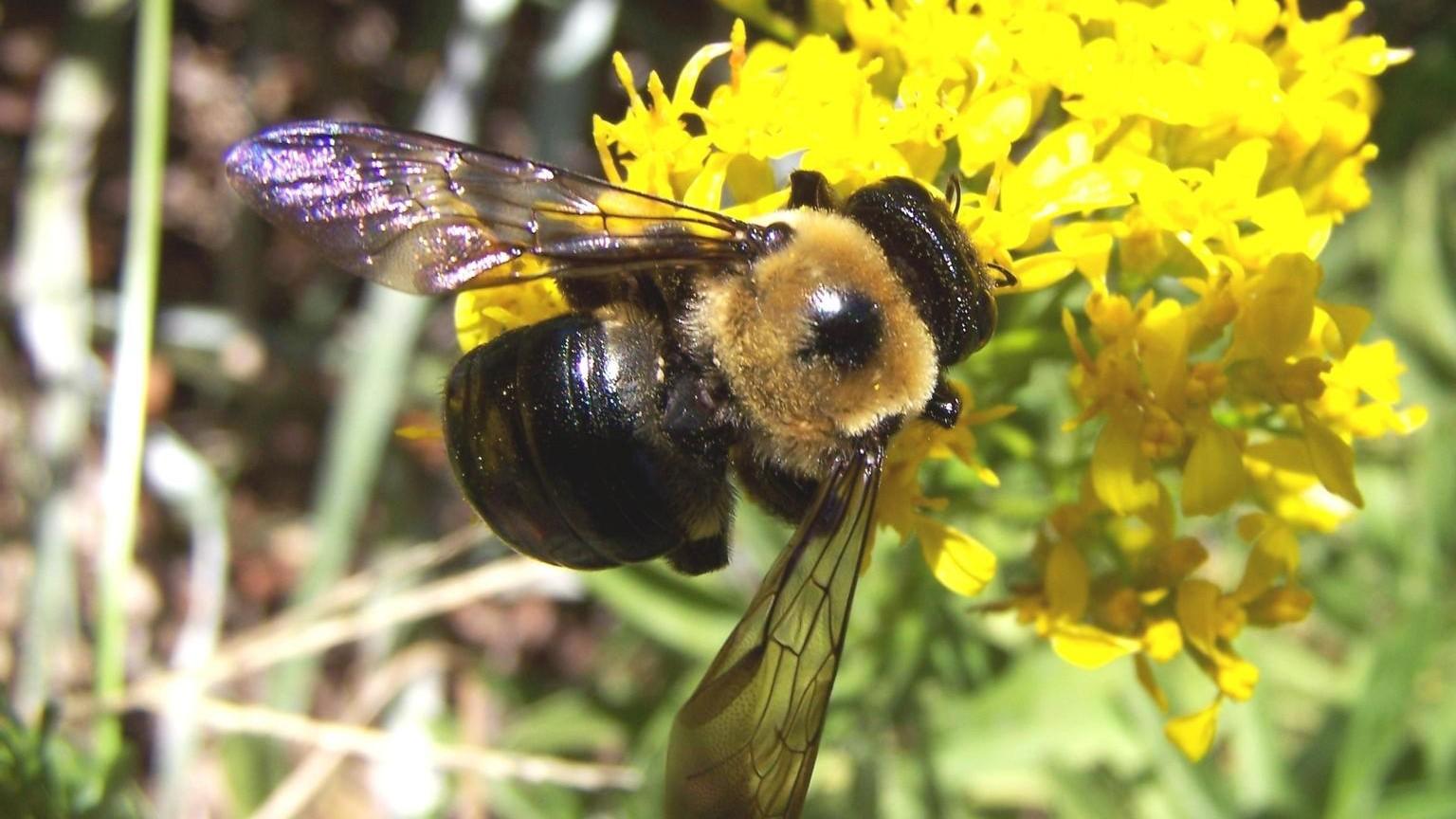About carpenter bees
-
Carpenter bees are a native species and like other native bees they are important pollinators, are not aggressive, and are only noticeable in late spring-early summer. Control is not necessary unless they are damaging wooden structures.
-
Signs of carpenter bees around your home or garden:
-
Sawdust piles below perfectly circular holes drilled into wood surfaces around your home.
-
Large, shiny, black, and yellow bees buzzing and flying around your head.
-
Fan-shaped, yellow, or moldy stains on the sides of a structure.
-
-
Carpenter bees do not eat wood, they eat flower nectar and pollen. The holes they bore into wood are nests for their young.
Identification
-
Eastern carpenter bees are large bees approximately 0.75-1 inch long.
-
The thorax or midsection is covered with yellow fuzz. The abdomen, or the hind section, is shiny and black.
-
Females have a black face and a dense brush of black hairs on their hind legs. Males have a yellow faces.
-
Carpenter bees are solitary bees. Each female builds her own nest by tunneling into wood. Carpenter bees are often mistaken for bumblebees, which are similar in size. However, the bumble bee’s entire body is covered with hairs, and females have yellow patches of hair on the top of the abdomen. Bumblebees are social, living together in an underground nest.
Life cycle
-
In April or May, the female carpenter bee searches for good nest sites. She will reuse and expand an existing nest tunnel or bore her own.
-
The female chews a perfectly circular hole approximately half an inch in diameter. This entry hole extends 1-2 inches into the wood and then turns at a right angle to follow the grain of the wood.
-
The nest, or gallery, is tunneled parallel to the grain of the wood and may extend for 6-12 inches. Many tunnels are lengthened and reused year after year by successive generations of bees.
-
Each new occupant improves a nest by excavating wood from the end of the tunnel.
-
At the extreme, nests have been found to measure up to 10 feet long.
-
Once the nest is complete, the female carpenter bee stocks the end of the tunnel with bee bread, which is a combination of flower pollen and nectar. She lays a single egg on the food mass, then seals the cavity, or brood cell, with a mixture of wood pulp and saliva. She repeats this process, filling the tunnel with a line of brood cells, each about an inch long. Each cell contains a food supply and a single egg.
-
During the nest construction phase, male carpenter bees patrol the site to drive away intruders and to fertilize females in the area. Although the males defend their territory aggressively and may alarm people by darting around their heads and buzzing loudly, male carpenter bees have no sting (sting is the correct term for "stinger") and are harmless.
-
Females can sting but they are docile and sting only when handled or touched.
-
Over the summer, bee larvae hatch in their nest cell and feed on the stored pollen and nectar. After the larva finishes feeding, it enters the pupal stage during which it transforms into an adult.
-
In late summer, the new adults emerge from the nest. They must chew their way out of the cells one at a time, so the oldest bee, hatched from the first laid egg, is the last one out.
-
Adult bees overwinter together in existing tunnels.
-
In the spring, they reemerge and begin the cycle again. A female bee often lays her eggs in the same gallery in which she developed.

Carpenter bee hole. Photo: David L. Clement, University of Maryland Extension
Structural damage to wood
- Female carpenter bees are attracted to raw, unfinished wood, or stained, weathered wood when searching for a nest site. Well maintained, painted wood is rarely attacked.
- Nail holes, splinters, and cracks in the face of the wood surface are inviting because they offer the bee a head start into the wood. Shingles, siding, decks, picnic tables, doors, sills, soffits, fascia, and fence posts are all popular nest sites, particularly when located near gardens and flower beds where the bees feed.
- Piles of coarse, yellow sawdust-like material are sometimes noticed below the hole. As the female bee excavates her nest, she pushes chewed wood out of the tunnel.
- She also excretes sticky yellow wastes, which may accumulate in a fan-shaped pattern on the side of the structure, adjacent to the hole. As the waste products age, they turn black with mold and will stain surfaces.
- Although the nest of a single bee will not cause structural damage, multiple tunnels from numerous bees and tunnels that are reused and expanded over several years may weaken wood. Thin shingles may be penetrated by the tunnels.
- In addition to the removal of interior wood, the nest sites are associated with several types of secondary damage due to
- Moisture entering the wood and accelerating the rate of decay.
- Mold growth on the yellow bee excrement.
- Woodpecker damage due to feeding on the immature bees.
 Carpenter bee stain. Photo: Lamar Merck, University of Georgia, Bugwood.org
Carpenter bee stain. Photo: Lamar Merck, University of Georgia, Bugwood.org
Prevention and management
- Prevention is the best approach to deter carpenter bees.
- By maintaining sound, finished wood surfaces, bees can be prevented from establishing nests around your home. Painted surfaces are unattractive to nesting bees. Nail holes and cracks should be filled with caulk or putty before painting.
- The best times to treat and repair damaged wood and minimize the killing of these pollinators would be late summer (after the summer emergence and before hibernation) or early spring before nest building begins. Carpenter bees are usually searching for nest sites in April-May.
- Non-wood surfaces and coatings, such as vinyl or aluminum siding will exclude carpenter bees entirely.
- Established nests can be eradicated by entirely removing and replacing the affected wood with a painted or otherwise unattractive (to the bees) surface.
- If tunnels are present treatment with an insecticide and sealing of the tunnel is a control option.
- Wasp, hornet, and bee aerosol formulations sprayed into the holes are effective. Apply the aerosol material into the tunnel entrances and along exposed surfaces. There are also insecticide dust formulations labeled for carpenter bee control. Dust is effective when small amounts are puffed into the tunnel. Chemicals are often repellent to the bees in large quantities so the objective is to lightly treat the inside of the tunnel entrances. In a properly treated tunnel, the returning bee spreads the compound throughout the tunnel and receives a lethal dose in the process. If pesticides are overused to the point of repellency the bees may avoid all contact with the tunnel and start over again in a nearby location. Read and follow all label directions.
- A week after treating the tunnels, the carpenter bees should be inactive, and wood can be caulked and repainted. Tunnels must be pre-treated with a pesticide before caulking or the bees will chew through the plugs and reemerge. If the wood surface as a whole is not improved, bees may reinfest the same area.
- If you choose to apply pesticide while the bees are active, wait until the female leaves the nest before application. Although the bees will not sting in defense of their nests, they often tumble out of the tunnel in response to the chemical. Treat for carpenter bees in the spring, just as the bees become active or in the late summer.
- Hire a pest control company if the carpenter bees are situated in an overhead, awkward-to-reach place, or if treatment is likely to involve the use of a ladder or step stool.
Additional resource
The Good and the Bad of Carpenter Bees: Can We Get Along? | Maryland Grows Blog
Carpenter Bees | University of Kentucky Entomology
Based on publication HG 29 Carpenter Bees, authors C.E. Mall, T.A Horner, N.L. Breisch (retired) and B.L. Thorne (retired), Department of Entomology, University of Maryland, College Park, MD 20742. Reviewed by Mary Kay Malinoski, UME Extension Specialist, Entomology. Complied by Debra Ricigliano, horticulturist, HGIC 2020.
